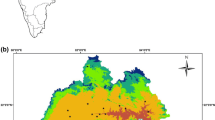Abstract
Regional flood frequency analysis has been carried out for estimating peak discharge at regional level over the Kerala State, India, along with at-site flood frequency analysis. For the study, the annual peak discharges of 43 gauging stations having length of data from 14 to 47 years spread over the Kerala State were used. Using L moments and L moment ratio, best fit distribution was identified among the five distributions; Generalised Extreme Value (GEV), Generalised Pareto Distribution (GPA), Generalised Logistic (GLO), Generalised Normal (LN3) and Pearson Type III (PE3) distribution for both at-site and regional flood frequency analysis. Chi-square test, ranking method using statistical indicators and L moment ratio diagram were used for identifying the best fit distribution for at-site flood frequency analysis. It was found that GPA was the best fit distribution for 27 stations, GLO for 14, LN3 for 1 station and GEV for 2 station. After discordancy test, five different homogeneous regions were identified through heterogeneity test to carry out the regional flood frequency analysis (RFFA). After identifying best-fit distributions for each zone, flood growth curves were derived by incorporating the catchment characteristics of the basins. The distribution that was best fit in case of at-site analysis for a gauging site is found to be entirely different than the best fit distribution resulted from RFFA. In RFFA, growth curves that provide the flood magnitude for various return periods can be used to estimate the flood magnitude and frequency at ungauged sites in each region of the Kerala State in India.










Similar content being viewed by others
References
Alam J, Muzzammil M, Khan MK (2016) Regional flood frequency analysis : comparison of L-moment and conventional approaches for an Indian catchment. ISH J Hydraul Eng:1–7. https://doi.org/10.1080/09715010.2016.1177739
Benameur S, Benkhaled A, Meraghni D, Chebana F, Necir A (2017) Complete flood frequency analysis in Abiod watershed, Biskra (Algeria). Nat Hazards 86(2):519–534
Chérif R, Bargaoui Z (2013) Regionalisation of maximum annual runoff using hierarchical and trellis methods with topographic information. Water Resour Manag 27:2947–2963. https://doi.org/10.1007/s11269-013-0325-0
Cunnane C (1988) Methods and merits of regional flood frequency analysis. J Hydrol 100:269–290. https://doi.org/10.1016/0022-1694(88)90188-6
CWRDM (1995) Water atlas. Centre for Water Resources Development and Management, Kozhikode, Kerala
Dalrymple T (1960) Flood-frequency analyses technical report water supply paper 1543-A. US Geological survey, Washington DC
Drissia TK, Jothiprakash V and Anitha AB (2018) Statistical classification of streamflow based on flow variability in west flowing rivers of Kerala, India, Theor Appl Climatol. https://doi.org/10.1007/s00704-018-2677-0
Haddad K (2013) Regional flood frequency analysis in the range of small to large floods : development and testing of Bayesian regression-based approaches. University of Western Sydney, Sydney, Australia
Heidarpour B, Saghafian B, Yazdi J, Azamathulla HM (2017) Effect of extraordinary large floods on at-site flood frequency. Water Resour Manag 31:4187–4205
Horton R (1945) Erosional development of streams and their drainage basins, Hydrophysical approach to quantitative morphology. Geol Soc Am Bull 56(3):275–370
Hosking JRM, Wallis JR (1993) Some statistics useful in regional flood frequency. Water Resour Res 29:271–281
Hosking JRM, Wallis JR (1997) Regional frequency analysis: an approach based on L-moments. Cambridge University Press, New York
IAC (1982) Guidelines for determining flood flow frequency: bulletin 17-B. Interagency Advisory Committee on Water Data, Hydrol. Subcomm., Washington, DC, p 28
Izinyon OC, Ehiorobo JO (2015) L-moments method for flood frequency analysis of river Owan at Owan in Benin Owena River basin in Nigeria. Current Advances in Civil Engineering 3(1):1–10
Kamal V, Mukherjee S, Singh P, Sen R, Vishwakarma CA, Sajadi P, Sajadi P, Asthana H, Rena V (2017) Flood frequency analysis of ganga river at Haridwar and Garhmukteshwar. App Water Sci 7(4):1979–1986
Kumar R, Chatterjee C (2005) Regional flood frequency analysis using L moments for North Brahmaputra region of India. J Hydrol Eng 10:1–7
Kumar R, Chatterjee C, Kumar S et al (2003) Development of regional flood frequency relationships using L-moments for middle ganga plains subzone 1(f) of India. Water Resour Manag 17:243–257. https://doi.org/10.1023/A:1024770124523
Noto LV, La Loggia G (2009) Use of L-moments approach for regional flood frequency analysis in Sicily, Italy. Water Resour Manag 23:2207–2229. https://doi.org/10.1007/s11269-008-9378-x
Pickands J (1975) Statistical inference using extreme order statistics. Ann Stat 3:119–131
Rahman A, Zaman MA, Haddad K et al (2015) Applicability of wakeby distribution in flood frequency analysis: a case study for eastern Australia. Hydrol Process 29:602–614. https://doi.org/10.1002/hyp.10182
Rao AR, Hameed KA (2000) Flood frequency analysis. CRC press, Washington D.C.
Rao AR, Srinivas VV (2008) Regionalization of watersheds an approach based on cluster analysis. Springer, Netherlands
Schumm SA (1956) Evolution of drainage systems and slopes in badlands at Perth Amboy, New Jersey. Geol Soc Am Bull 67:597–646
Strahler AN (1964) Quantitative geomorphology of drainage basins and channel networks section 4-2. In: te Chow V (ed) Handbook of applied hydrology. McGraw-Hill, New York, pp 4–35
Viglione A, Merz R, Salinas JL, Blöschl G (2013) Flood frequency hydrology: 3. A Bayesian analysis. Water Resour Res 49:675–692. https://doi.org/10.1029/2011WR010782
Zkhiri W, Tramblay Y, Hanich L, Berjamy B (2017) Regional flood frequency analysis in the high atlas mountainous catchments of Morocco. Nat Hazards 86(2):953–967
Acknowledgements
The authors are thankful to Central Water Commission, Govt. of India and Water Resources Department, Govt. of Kerala for sharing the discharge data.
Author information
Authors and Affiliations
Corresponding author
Ethics declarations
Conflict of Interest
None.
Additional information
Publisher’s Note
Springer Nature remains neutral with regard to jurisdictional claims in published maps and institutional affiliations.
Rights and permissions
About this article
Cite this article
Drissia, T.K., Jothiprakash, V. & Anitha, A.B. Flood Frequency Analysis Using L Moments: a Comparison between At-Site and Regional Approach. Water Resour Manage 33, 1013–1037 (2019). https://doi.org/10.1007/s11269-018-2162-7
Received:
Accepted:
Published:
Issue Date:
DOI: https://doi.org/10.1007/s11269-018-2162-7




